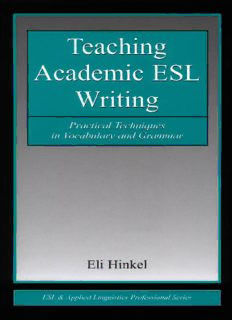
Teaching Academic ESL Writing: Practical Techniques in Vocabulary and Grammar PDF
Preview Teaching Academic ESL Writing: Practical Techniques in Vocabulary and Grammar
TLFeBOOK TEACHING ACADEMIC ESL WRITING Practical Techniques in Vocabulary and Grammar TLFeBOOK ESL & Applied Linguistics Professor Series Eli Hinkel, Series Editor Birch • English L2 Reading: Getting to the Bottom Fotos/Browne • New Perspectives on CALL for Second Language Classrooms Hinkel • Second Language Writers' Text: Linguistic and Rhetorical Features Hinkel • Teaching Academic ESL Writing: Practical Techniques in Vocabulary and Grammar Hinkel/Fotos, Eds. • New Perspectives on Grammar Teaching in Second Language Classrooms TLFeBOOK Teaching Academic ESL Writing Practical Techniques in Vocabulary and Grammar Eli Hinkel Seattle University LAWRENCE ERLBAUM ASSOCIATES, PUBLISHERS 2004 Mahwah, New Jersey London TLFeBOOK Copyright © 2004 by Lawrence Erlbaum Associates, Inc. All rights reserved. No part of this book may be reproduced in any form, by photostat, microform, retrieval system, or any other means, without prior written permission of the publisher. Lawrence Erlbaum Associates, Inc., Publishers 10 Industrial Avenue Mahwah, NJ 07430 Cover design by Kathryn Houghtaling Lacey Library of Congress Cataloging-in-Publication Data Hinkel, Eli. Teaching Academic ESL writing : practical techniques in vocabulary and grammar / Eli Hinkel. p. cm. Includes bibliographical references and index. ISBN 0-8058-3889-9 (cloth : alk. paper) ISBN 0-8058-3890-2 (pbk. : alk. paper) 1. English language—Rehtoric—Study and teaching. 2. English language— Study and teaching—Foreign speakers 3. Academic writing—Studying and teaching. I. Title. PE1404.H57 2003 808'042'071—dc21 2003046234 CIP Books published by Lawrence Erlbaum Associates are printed on acid- free paper, and their bindings are chosen for strength and durability. Printed in the United States of America 10 9 8 7 6 5 4 3 21 TLFeBOOK To RH with love and gratitude TLFeBOOK This page intentionally left blank TLFeBOOK Contents Preface ix Part I Academic Text and Teaching Second Language Writing 1 The Importance of Text in Written Academic 3 Discourse: Ongoing Goals in Teaching ESL Skills 2 Student Writing Tasks and Written Academic Genres 17 3 Curriculum for Teaching the Language Features 33 of Academic Writing Part II Sentences and Their Parts: Lexis and Grammar 4 Sentences, Phrases, and Text Construction 65 5 Nouns and the Noun Phrase 95 6 More on the Noun Phrase: Pronouns 125 7 Teaching Verb Tenses and Voice in Text Cohesion 143 8 Lexical Classes of Verbs: Meanings and Text Functions 177 9 Adjectives and Adverbs in Academic Discourse 209 vii TLFeBOOK viii CONTENTS Part III Text and Discourse Flow: The Sentence and Beyond 10 Backgrounding Discourse and Information: 241 Subordinate Clauses 11 Rhetorical Features of Text: Cohesion and Coherence 279 12 Hedging in Academic Text in English 313 References 337 Author Index 353 Subject Index 357 TLFeBOOK Preface Language is power. —Angela Carter Power to the people. —A slogan from the 1960s Since the late 1970s and early 1980s, a great deal of time, energy, and re- sources have been devoted to teaching non-native L2 writers the rhetorical features of written academic discourse in English. In addition, to meet mar- ket demands and the expectations of professional training and preparation for English as a Second Language and English for Academic Purposes teachers, teacher-training and graduate programs have set out to address teachers' on-the-job skills that pertain to teaching L2 academic writers how to generate and organize ideas into coherent essays and compositions, as is expected of practically all students at undergraduate and graduate levels. There is little doubt that L2 writers need to be familiar with many rhetor- ical and discourse features of written English and that the teaching of col- lege- or university-level writing cannot do without them. In teaching L2 writing to academically bound learners, what has become of smaller impor- tance, however, is the language tools (i.e., the grammar and vocabulary that L2 writers must have to construct academic text, which in turn can be orga- nized into a coherent written academic discourse). To put it plainly, no mat- ter how well discourse is organized or how brilliant the writer's ideas may be, it would be hard to understand them if the language is opaque. The purpose of this book is to bridge an important gap that exists in teacher training today: the teaching of the second language and its gram- matical and lexical features that are essential for any L2 writing teacher and student writer to know. The teaching of rhetorical and discourse properties of academic writing in English can be made far more effective and efficient if L2 learners have language tools with which to build the text. The ultimate ix TLFeBOOK
Description: